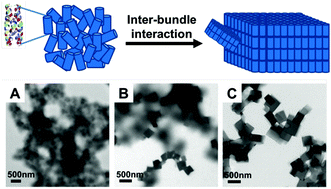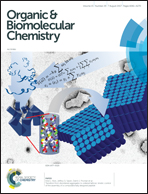Transition from disordered aggregates to ordered lattices: kinetic control of the assembly of a computationally designed peptide†
Abstract
Natural biomolecular self-assembly typically occurs under a narrow range of solution conditions, and the design of sequences that can form prescribed structures under a range of such conditions would be valuable in the bottom-up assembly of predetermined nanostructures. We present a computationally designed peptide that robustly self-assembles into regular arrays under a wide range of solution pH and temperature conditions. Controling the solution conditions provides the opportunity to exploit a simple and reproducible approach for altering the pathway of peptide solution self-assembly. The computationally designed peptide forms a homotetrameric coiled-coil bundle that further self-assembles into 2-D plate structures with well-defined inter-bundle symmetry. Herein, we present how modulation of solution conditions, such as pH and temperature, can be used to control the kinetics of the inter-bundle assembly and manipulate the final morphology. Changes in solution pH primarily influence the inter-bundle assembly by affecting the charged state of ionizable residues on the bundle exterior while leaving the homotetrameric coiled-coil structure intact. At low pH, repulsive interactions prevent 2-D lattice nanostructure formation. Near the estimated isoelectric point of the peptide, bundle aggregation is rapid and yields disordered products, which subsequently transform into ordered nanostructures over days to weeks. At elevated temperatures (T = 40 °C or 50 °C), the formation of disordered, kinetically-trapped products largely can be eliminated, allowing the system to quickly assemble into plate-like nanostructured lattices. Moreover, subtle changes in pH and in the peptide charge state have a significant influence on the thickness of formed plates and on the hierarchical manner in which plates fuse into larger material structures with observable grain boundaries. These findings confirm the ability to finely tune the peptide assembly process to achieve a range of engineered structures with one simple 29-residue peptide building block.

- This article is part of the themed collection: Peptide Materials


 Please wait while we load your content...
Please wait while we load your content...